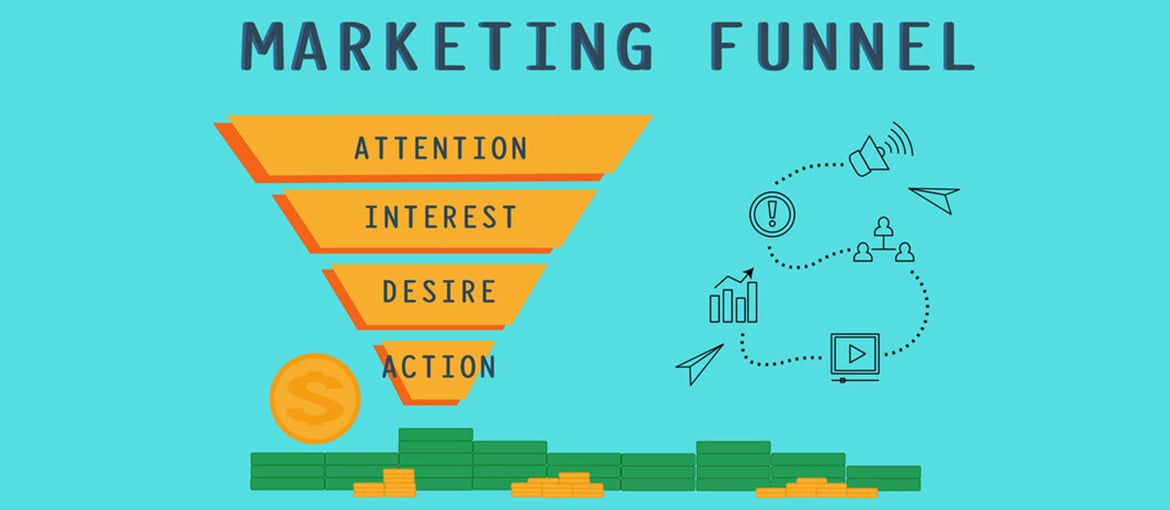Table of Contents
What is the marketing funnel? How do you create one? How do you create a customer journey map?
Every company needs to attract, convert and keep new customers to continue growing, or simply function properly. It’s something that can seem daunting in both theory and practice: indeed, understanding people’s needs and turning them into sales has never been more complex. Until fairly recently, businesses tried to visualise the customer journey from first contact to sale through the famous marketing funnel, but can it still be applied today?
The marketing funnel: a definition
What is the marketing funnel? The marketing funnel is a graphical representation of the process of turning leads into customers. But why a funnel? Well, the shape reflects the fact that most people will not complete this journey of transformation from prospects into sales by moving from the wide part of the funnel to the narrow part. Initially, a firm will aim for as broad a target as possible, but those who are eventually converted into customers will be a much smaller group than the original target.
Ideally, the process would be represented by a cylinder shape, because brands want to turn every potential customer into a sale. But in reality, the process is much more complex and the funnel can take on various shapes and be built on more than one level, depending on the context. So how do you create a funnel? There are a plethora of marketing funnel models that you can adopt for your strategy, but the best known is the AIDA framework. It was devised in 1898 by American Elias St. Elmo Lewis, whose motto was: “attract attention, maintain interest, create desire, get action”. The AIDA model identifies the cognitive phases that an individual goes through in the process of buying a product or service.
These phases are:
- Awareness: the first step is to attract the attention of potential customers. If you don’t do this, you won’t be able to get your message across. So how do you make prospects aware of your products or services? What is your awareness-building strategy? What tools will you use? What should the messages be?
- Interest: once you’ve captured their attention, you need to maintain people’s interest. So what’s your strategy for content? How do you make this information available and where?
- Desire: desire is fundamental in the sales phase. If customers don’t have desire, they don’t buy. So what makes your product or service desirable? How do you create an emotional connection with customers?
- Action: now that customers have noticed you, are interested and desire your product, you need to help them to act. Is it easy for customers to make a purchase?
Although it’s well structured, this model doesn’t optimally capture the complexity of modern marketing. For example, it doesn’t take into account the post-purchase phase, when brands look to build customer loyalty.
A new perspective and new models
The complex nature of the fourth revolution (Luciano Floridi) that we’re living through has already led to enormous changes in people’s desires. The COSMS pyramid, an update of Maslow’s classic hierarchy of needs, shows us how people’s new needs are connection, orientation, sociability, mediality and self-celebration. It’s in this context that new, more flexible takes on the classic – and static – marketing funnel have emerged. Two particularly dynamic frameworks are Kaushik’s See Think Do Care model and Kotler’s Five As.

The See Think Do Care model
The See Think Do Care (STDC) model is based on three fundamental concepts: the centrality of the customer, which must be tangibly expressed in actions, not just words; the role of marketing, which is essential for each step; and the importance of measurement and setting the right metrics.
The model has four separate steps.
1.See
The goal of the first step, See, is to inspire people and doing so involves creating content that has nothing to do with sales. It focuses on the dreams of customers who aren’t yet ready to receive promotional messages. What’s more, it seeks to reach the widest possible qualified audience to maximally leverage the potential of inbound marketing (marketing that attracts people through compelling content and value-added experiences).
2.Think
Next comes the Think phase in which people want to find information, but their purchasing intentions are still very weak. This is the phase at which you can really stand out from competitors thanks to useful and valuable content.
3.Do
The Do step is where the conversion happens. People have now been inspired and informed, and are interested in your product or service. But now you need to be careful not to push the customer towards a purchase, but help them in satisfying their needs.
4.Care
Last of all, in the Care phase, the goal is to look after the people that you have converted into customers. It’s the most important part of the framework as it broadens your base of loyal customers, who are more likely to make a repeat purchase having completed the first three steps. Fundamental to this is personalised and exclusive content, for example, content that’s only available in premium areas.

The 5A model
The 5A model conceived by Kotler takes into account the changes brought about by connectivity:
- Many seemingly personal decisions are, in reality, social decisions
- Loyalty means the willingness of customers to recommend a product
- To get to know a brand, people actively connect to one another, creating ask-and-advocate relationships
Once you know this, the customer can be rewritten using the five As: aware, appeal, ask, act and advocate.
1.The Aware phase
In the aware phase, brand awareness is crucial since customers are passively exposed to a wide range of stimuli through past experiences, communications and suggestions from other people.
2.The Appeal phase
Once people know what’s out there, they are attracted to a limited number of brands. This is the appeal phase in which the brands that are most skilled at compelling storytelling are able create a favourable impression in people’s minds.
3.The Ask phase
Spurred on by curiosity, customers begin to gather more information independently through the Internet or by asking for recommendations from friends. We’re now in the ask phase, which can be particularly tricky due to the mixture of online and offline methods. For example, when customers are in a shop, they can look for information at the same time on their smartphone. This is also the phase where the purchasing process becomes social, as often the approval of others is needed to continue down the funnel.
4.The Act phase
We’ve now reached the moment for customers to act. Remember that possible actions are not limited to a single transaction, but include after-sales too. So it’s important to ensure that the overall experience, from purchase to use to the resolution of any problems, is positive and memorable.
6.The Advocate phase
If a product really satisfies the needs of customers, they may develop a sense of loyalty and spontaneously recommend it to others. This is the advocate phase in which satisfied customers drive sales through word of mouth.

From the funnel to the customer journey via engagement
If the classic marketing funnel no longer accurately reflects reality, why do marketers still use it? Well, it’s because this model is reassuring, linear and measurable. What both new models share in common compared to AIDA – and what elevates them from the vertical concept of the funnel to a circular and dynamic vision – is customer care and the relationship developed with them. The purchase process is fragmented into many micro-moments, there are numerous ways of achieving online and offline conversion, word of mouth is amplified by new means of communication and customers can begin their journey by skipping one or more steps. The switch from the marketing funnel to the customer journey represents a pathway built around different points of contact between the brand and people that are known as touchpoints.
So how do you create a customer journey map? You need to find the points where the goals of the prospect and brand are aligned so that you can identify and track touchpoints to create a more realistic model compared to the traditional funnel.
When trialling a new model or touchpoint, the key metric of success is engagement. A business must forge connections with customers that involve them and make them feel they are at the centre of the relationship. This goal can only be achieved through one-to-one dialogue, interaction that achieves a deeper level of engagement and makes customers feel special, thus giving them an unforgettable pre- and post-sales experience to consolidate the brand’s positioning.



